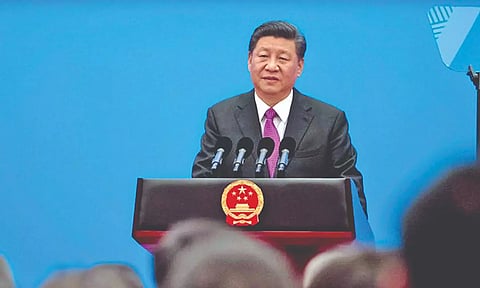

By CHIA-CHUN YEH
WASHINGTON: China is hosting its third Belt and Road summit this week, marking the 10th anniversary of its iconic Belt and Road Initiative (BRI). Worldwide leaders and representatives from over 100 countries are gathering in Beijing, including Russian President Vladimir Putin.
Putin is keen on intensifying relations with China and showing that he is not isolated internationally, Russia expert at the University of Leipzig, Alexei Chigadaev, told DW. Russian Foreign Minister Sergei Lavrov will also be present as Chinese President Xi Jinping heralds a milestone for his “Chinese Dream.”
In 2013, shortly after becoming president, Xi proposed the ambitious concept of “One Belt One Road,” which has since been recognized as the core of China’s “major-country diplomacy” and an essential strategy for realizing the “Chinese Dream.”
Ten years on, the BRI has expanded to Europe, Asia, Africa, and Latin America, far exceeding the scale of the ancient Silk Road, but it seems to be facing more challenges than ever before. According to Germany’s Strategy on China, Beijing’s political initiatives, such as the BRI, provide the framework for China’s political and geoeconomic relations on all continents.
For example, in some countries, infrastructure loans have contributed to unsustainable debt levels and created strong political dependencies. As of June 2023, China has signed over 200 Belt and Road cooperation agreements with 152 countries and 32 international organizations.
The BRI has exceeded $1 trillion in cumulative participation since its inception in 2013, according to the Green Finance and Development Center at Fudan University.
Chien-fu Chen, Executive Director of the Belt and Road Research Center at Tamkang University in Taiwan, told DW that for the Xi Jinping administration, achieving the “Chinese Dream” through the BRI is not only about gaining real power but also about balancing against the West. From this perspective, he believes the initiative is “largely successful.”
“The BRI has now reached Africa, Central America, and even Southeast Asia. It has also extended to the South Pacific islands beyond the so-called second island chain. It is constantly evolving with international situations and China’s friendly relations. The BRI has transformed from early-stage infrastructure construction to energy control and has become an important strategic military outpost. China hopes to push its diplomatic, military, and political influence outward through national efforts,” according to Chen.
Yun Sun, Co-Director of the East Asia Program and Director of the China Program at the Stimson Center, told DW: “One piece of the China Dream is China helping the less developed countries to grow. Some would say China did achieve that.”
In October, Indonesia’s Jakarta-Bandung High-Speed Railway just opened. This flagship project is built by a joint venture of Chinese and Indonesian state-owned enterprises. China provides part of the funding through loans.
The railway is the first high-speed railway in Southeast Asia and China’s first overseas high-speed rail project, raising hopes of boosting economic development and attracting investment for the Indonesian government. However, this does not mean the BRI has not faced setbacks.
China recently released a white paper on the BRI, stating that from 2013 to 2022, direct investment in co-building countries exceeded $240 billion, and “not a single country has fallen into a debt crisis due to participating in Belt and Road cooperation.”